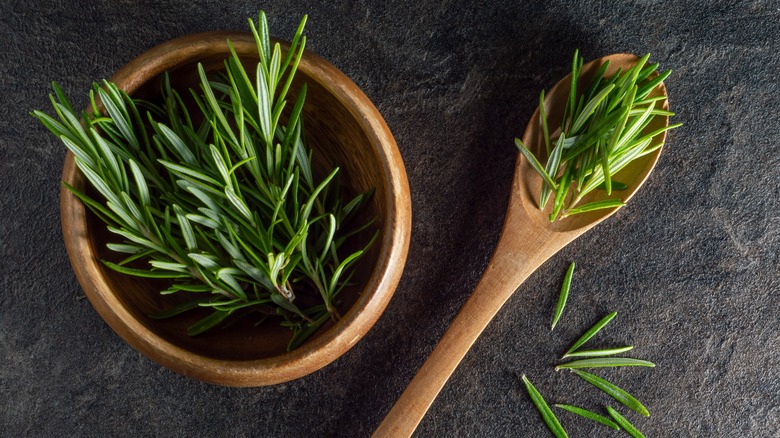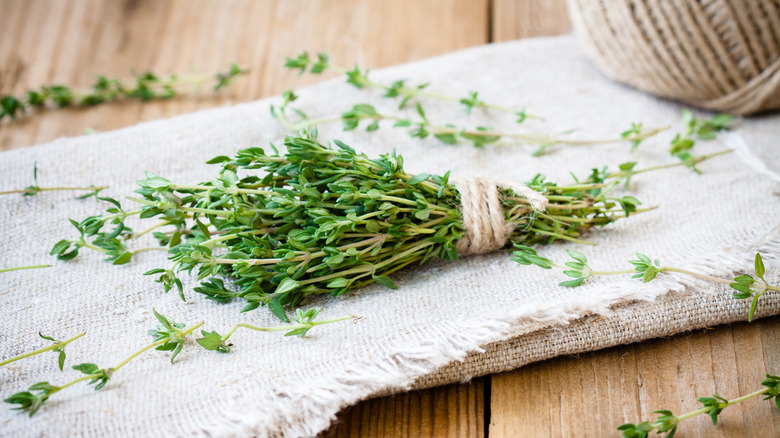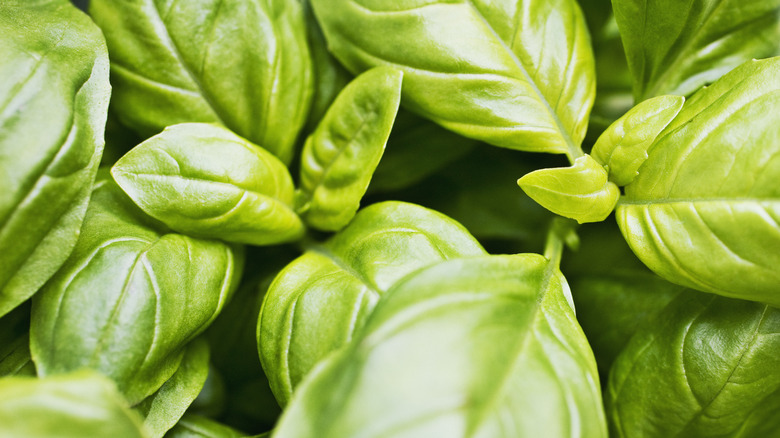Is There An Official Definition For A Sprig Of Herbs?
Recipes can sometimes be littered with approximations and loose measurements, especially when instructions have been passed down through generations of home cooks. Teaspoons and tablespoons give us exactness, something to be sure of. But what about more vague terms? A bunch, a handful, a bit ... none of these terms are more elusive than a "sprig." When it comes to cooking with herbs, what does a sprig define? Should you measure a sprig of herbs by the fullness of the leaves on the stem? Then, how many leaves should you use? Do you have to be exact?
A sprig is defined as a "small stem with leaves on it ... especially so that it can be used in cooking," according to Collins Dictionary. But when it comes to making and interpreting recipes, one cook's idea of a "small stem" could differ from another. However, there are some standard guidelines to follow when you face the elusive "one to two sprigs" in the ingredients list of a recipe. These guidelines slightly differ based on what herb you're working with, especially if you're substituting dry herbs for fresh herbs.
Sprigs of woody herbs
A sprig can vary in size and be as long as six inches in length, but let's break down the ideal size of a woody herb you'll frequently see referenced in sprigs: Thyme. When you purchase fresh thyme, you may find the stems sometimes off-shoot into a few more branches, creating more of those small thyme leaves. Or you have just a single stem with no branches and fewer leaves.
Consider the Goldilocks rule here. A single stem doesn't have enough leaves to be considered a sprig, but a stem with a bunch of branches is going to have too much. So look for the stems with just a few branches, about three inches long — those are sprigs, and they'll be just right.
As for rosemary or tarragon, other woody herbs, you can follow a similar measurement to thyme. Three to four inches long is a good length to constitute a sprig of these herbs. Since these particular herbs have thick, woody branches and smaller leaves, measuring this way works when the herb is measured from the terminal stem, or the top of the herb, where the leaves are at their fullest. And if your recipe calls for only one sprig and you have lots left over, don't throw away the herbs. You can try your hand at drying them out for long-term use instead.
Defining a sprig for common leafy herbs
The word "sprig" can bring to mind the twigs or sticks of the woody herbs we've already touched on. But occasionally, you'll find you're asked to procure a sprig of basil or even peppermint. To measure these leafy herbs effectively, disregard the more delicate stems. Pluck the leaves from their stems, and then you can measure how much of them constitutes a sprig.
For basil, consider a sprig to be the few leaves at the top, about three or four leaves clustered close together. And if you're harvesting from a fresh basil plant at home, it's especially important to get your leaves from the top to help the plant grow fuller and larger. For mint, it's essential to measure a sprig after the leaves are chopped since mint leaves vary in size. About eight to ten chopped mint leaves should create one tablespoon and one tablespoon of chopped mint leaves is considered a single sprig.
Since the definition of sprig varies by herb and leaf sizes, you'll often have to use your best judgment to size up the herbs while cooking. But fresh herbs bring aromatic and earthy layers to your dishes, so it's surely not the end of the world if you add a bit too much. Follow your recipe and then follow your taste buds, and your sprig of herbs will bring new depths to your next meal.


